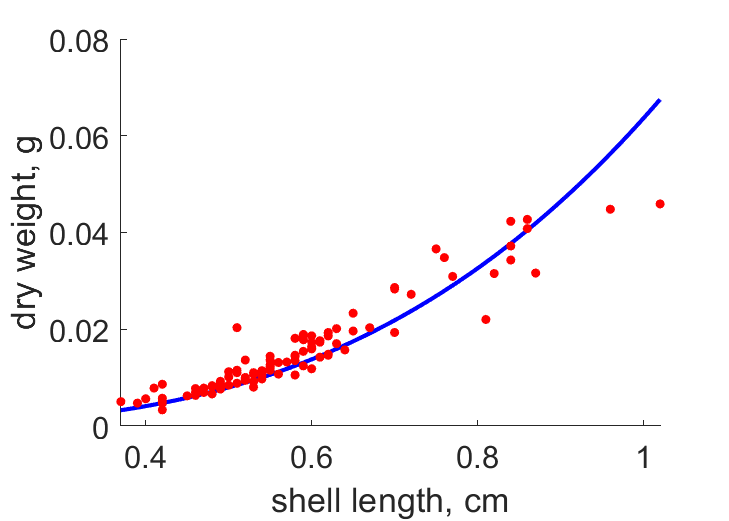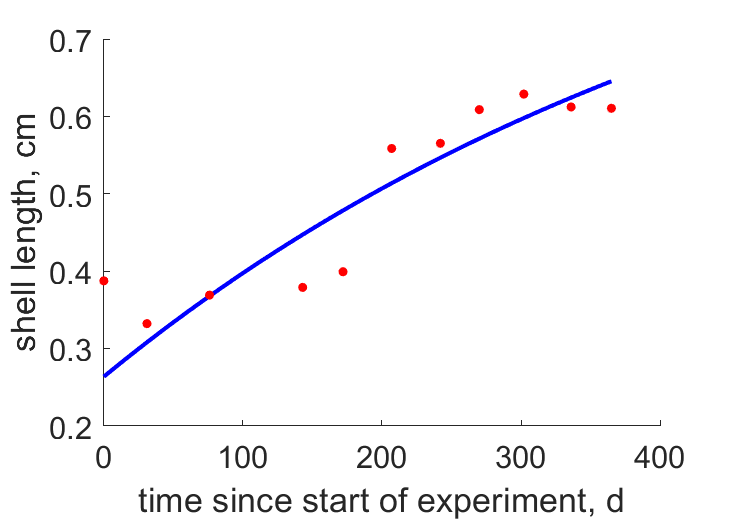Predictions & Data for this entry
| Model: stx | climate: C, D | migrate: | phylum: |
| COMPLETE = 2.5 | ecozone: THp | food: biPp | class: |
| MRE = 0.049 | habitat: 0iFm, 0iFp | gender: D | order: |
| SMSE = 0.010 | embryo: Fbb | reprod: O | family: |
Zero-variate data
| Data | Observed | Predicted | (RE) | Unit | Description | Reference |
|---|---|---|---|---|---|---|
| ax | 60 | 61.38 | (0.02293) | d | age at emergence | Thie1928 |
| tp | 90 | 93.95 | (0.04394) | d | time since emergence at puperty | usgs |
| am | 1095 | 1095 | (5.979e-06) | d | life span | usgs |
| L0 | 0.00608 | 0.00608 | (5.841e-05) | cm | initial egg length | Step1865 |
| Lx | 0.2 | 0.2023 | (0.01149) | cm | shell length at emergence | Hear1977 |
| Lp | 0.5 | 0.4564 | (0.08716) | cm | shell length at puberty | HoloPent1993 |
| Li | 1.4 | 1.486 | (0.06157) | cm | ultimate shell length | usgs |
| Ri | 0.4786 | 0.4803 | (0.003584) | #/d | maximum reprod rate | Voel2015 |
Uni- and bivariate data
| Data | Figure | Independent variable | Dependent variable | (RE) | Reference |
|---|---|---|---|---|---|
| LW |  | shell length | dry weight | (0.169) | Data2017 |
| tL |  | time since start of experiment | shell length | (0.08726) | GallMore1988 |
Pseudo-data at Tref = 20°C
| Data | Generalised animal | Sphaerium corneum | Unit | Description |
|---|---|---|---|---|
| v | 0.02 | 0.02475 | cm/d | energy conductance |
| p_M | 18 | 32.23 | J/d.cm^3 | vol-spec som maint |
| k_J | 0.002 | 0.002 | 1/d | maturity maint rate coefficient |
| k | 0.3 | 0.1458 | - | maintenance ratio |
| kap | 0.8 | 1 | - | allocation fraction to soma |
| kap_G | 0.8 | 0.8016 | - | growth efficiency |
| kap_R | 0.95 | 0.95 | - | reproduction efficiency |
Discussion
- The ab-data of Thie1928 refers to the development of the juveniles inside the adults. Referring to Hear1977 the development from S. corneum takes place in brood sacs. Primary sacs contain embryos, secondary sacs fetal larvae, and tertiary sacs prodissoconch larvae. The young start feeding on epithelial cells within the brood sacs. (Blan1988) The extra-marsupial larvae remain for some time inside the adult and feed on algae.
- Hear1977 found that eggs and sperm in the extra-marsupial larvae in most species of Sphaerium. This leads to the assumption that maturity in Sphaerium corneum takes place before the young are released from the adult
Facts
- no veliger stage; the neonate develops in the mantle cavity of the mother till age 60 d (Ref: Hear1977)
Acknowledgment
- This entry was financially supported by the CEFIC Long-range Research Initiative (project number ECO28)
Bibliography